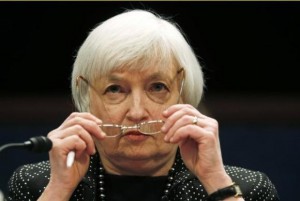
- Total leverage for large buyouts averages 5.91x EBITDA in Q1
- Leverage levels hit peak of 6.96x EBITDA in Q3 2014
- Barclays expects most LBOs to have leverage below 6x this year
Total leverage for large buyouts announced in the first quarter of 2015 to date averaged 5.91 times EBITDA, below the six times levels that regulators are trying to get banks to avoid, TRLPC data shows.
U.S. regulators issued leveraged lending guidelines in March 2013 and made it clearer late last year that they have little tolerance for highly leveraged loans, which could trigger penalties for banks.
The drop in leverage ratios shows that lenders are heeding regulators’ guidance. Leverage ratios averaged 6.55 times last year and recently peaked at 6.96 times in the third quarter of 2014.
The last time that leverage levels were below six times was the first quarter of 2013, after reaching a high of 7.4 times in the second quarter of 2007 before the financial crisis.
“The market is beginning to digest increasing adherence of the guidance,” said Chris Remington, institutional portfolio manager at Eaton Vance.
Changing tune
Wall Street banks initially maintained that every company that wanted to raise a highly leveraged loan would be able to do so after regulators issued the leveraged lending guidelines, but that tune has changed.
Leverage levels started to fall after the Federal Reserve, the Office of the Comptroller of the Currency and Federal Deposit Insurance Corp notified banks of more frequent reviews and started to take a harder line on enforcing their guidelines last November.
An FDIC spokesman referred to a February 24 statement from a quarterly banking profile briefing, in which Chairman Martin Gruenberg noted that leveraged lending “has been a particular concern, really a credit quality concern,” for larger institutions.
After an initially unsatisfactory response to the guidance, “we’re now hopeful that we’re going to see a better response from the industry … but that remains an area of attention for us,” said Gruenberg.
The Fed and OCC declined to comment on the declining leverage trend and bank response to the guidance.
Only one leveraged buyout loan – for U.K. software and information technology company Advanced Computer Software Group Plc – has had leverage of more than seven times in the first quarter so far, in contrast with the third quarter of 2014, when nearly half of all leveraged loans had leverage of more than seven times, according to LPC data.
“There’s still some ambiguity about what the guidelines mean in practice, but caution is taking hold,” said Anna Dodson, a partner in Goodwin Procter’s debt finance practice.
Caution started to be seen in late 2014 on a $4.3 billion loan backing PetSmart’s buyout by a private equity group led by BC Partners. Leverage ratios estimated as high as 7.25 times prompted several banks to stay away from the deal.
“None of the banks who passed decided to pass because of the credit. They had questions over the regulations,” Raymond Svider, a managing partner at BC Partners, said on Wednesday.
Here to stay?
Barclays strategists now see more frequent oversight from U.S. regulators leading to fewer deals with leverage exceeding six times EBITDA, in an about- face on the bank’s previous view.
Leveraged buyout loans have accounted for 20 percent of total loan supply in the last five years, excluding repricings, and LBOs with leverage greater than six times made up 11 percent, according to Barclays, which expects leveraged loan volume to drop as some highly leveraged deals are abandoned.
Barclays expects most LBOs to have leverage below six times and volume to fall to 10-15 percent of total issuance this year, resulting in a $15 billion to $35 billion drop.
“To account for the likelihood of this regulatory-driven decrease in issuance, we reduce our full-year forecast to $305 billion-$330 billion, ex-repricings, from the $325 billion-$350 billion supply forecast in November,” the Barclays report said.
Bank of America Merrill Lynch strategists also believe that stricter compliance with regulatory guidance will continue to depress large bank lending.
The firm’s strategists said that “at least $40 billion in issuance this year will not get done due to regulatory scrutiny, and by our estimation the number could be as high as $80 billion less in issuance due to policy alone.”
(By Lynn Adler, TRLPC. Additional reporting by Jonathan Schwarzberg) (Editing By Tessa Walsh and Michelle Sierra)


 If you do not receive this within five minutes, please try and sign in again. If the problem persists, please
email:
If you do not receive this within five minutes, please try and sign in again. If the problem persists, please
email: